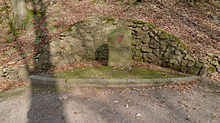Karl Peix
Karl Peix (born March 27, 1899 in Herzberg am Harz , † November 6, 1941 in Goslar ) was a German politician ( KPD ) and Nazi victim.
Life
After finishing his school career, Peix completed an apprenticeship as a brush maker. At the First World War Peix participated as a soldier. After the end of the war, he worked as a contractor in the enamelling factory of Lauterberg MIAG from December 1919. There he was committed to employee issues and was dismissed as a result. He became a member of the USPD in 1920 and switched to the KPD in Bad Lauterberg in the Harz Mountains in 1921, where he was one of the founders. Peix became chairman of the KPD in the Lauterberg subdistrict in 1928. Furthermore, he was a member of the city council of Bad Lauterberg and received mandates in the Osterode district assembly and in the Hanover provincial assembly. Peix was also involved in a street battle with SA members . After a trial by SA members against Peix for breach of the peace, he was acquitted, but Nazis committed several attacks on his house and his person.
After the transfer of power to the NSDAP in 1933 and the defeat of the KPD, Peix continued his political and anti-fascist activities illegally and took part twice as a speaker at party events of the KPD in the Harz region. Peix was arrested in Hanover in October 1933; he carried extensive, illegal KPD publications with him.
After being in prison in 1937, Peix was finally transferred to the Buchenwald concentration camp, where he was used as a medic in the infirmary. In April 1939 he became the deputy prisoner nurse under Walter Krämer , whom he had known since 1932. In the infirmary, contrary to the express instructions of the SS, they also looked after Soviet prisoners who had been brought to the camp as prisoners of war. Krämer and Peix together with Paul Grünewald founded a resistance group in the infirmary and continued to participate in the camp resistance. In the autumn of 1941, on the instructions of the camp commandant Karl Otto Koch , Krämer and Peix were transferred to the Goslar external command, where they were both shot in quick succession on November 6, 1941. Their bodies were cremated on November 8, 1941 in the Buchenwald crematorium. The background for the murder of Peix and Krämer could be their knowledge of Koch's syphilis treatment , which he had carried out in secret by the two inmates, or Peix and Krämer's participation in the camp resistance.
Peix's wife Marie, whom he met in 1919 and who was also a member of the KPD, survived imprisonment in the concentration camp. In Bad Lauterberg, a memorial stone erected by the VVN on the Felsenkeller has been commemorating the communists and Nazi victims Karl Peix, Otto Bockelmann and Bruno Maue since September 11, 1949 . Peix's urn is buried in the Bad Lauterberg forest cemetery.
See also
literature
- Hans-Heinrich Hillegeist: Karl Peix (1899–1941). The most famous communist in the Osterode district . In: Heimatblätter for the south-western Harz border 56, 2000, pp. 68–84.
Web links
- On the history of the anti-fascist resistance (PDF; 724 kB) at www.inventati.org
- Bernd Langer: On the anti-fascist history in the southern Harz at www.spurensuche-harzregion.de
- The unequal. On the 65th anniversary of the murder of Walter Krämer and Karl Peix in the Goslar satellite camp (PDF; 281 kB)
Individual evidence
- ↑ The thin line: Resistance in Buchenwald concentration camp ( Memento of the original from October 7, 2013 in the Internet Archive ) Info: The archive link was inserted automatically and has not yet been checked. Please check the original and archive link according to the instructions and then remove this notice.
| personal data | |
|---|---|
| SURNAME | Peix, Karl |
| BRIEF DESCRIPTION | German politician (KPD) and concentration camp prisoner |
| DATE OF BIRTH | March 27, 1899 |
| PLACE OF BIRTH | Herzberg am Harz |
| DATE OF DEATH | November 6, 1941 |
| Place of death | Goslar |

